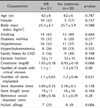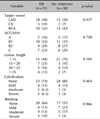Abstract
Background
In-stent restenosis (ISR) is the major limitation of percutaneous coronary stenting procedure. The elements like nickel, chromate and molybdenum are known to cause contact allergy. Hypersensitivity reaction, against these metal ions, may be one of the reasons of ISR. Cobalt chromium coronary stents, which are increasingly being used in percutaneous coronary interventions, have more nickel amount than the stainless steel stents.
Objective
We aimed to investigate the association between nickel hypersensitivity reaction and ISR in patients treated with cobalt chromium coronary stents.
Methods
Epicutaneous patch tests for nickel were applied to 31 patients who had undergone elective cobalt chromium coronary stent implantation and had ISR in control angiogram. Thirty patients, without ISR, were included as the control group. Patch test results and other clinical variables were compared.
Results
There was no statistically significant difference of the mean age, sex, body mass index, rate of hypercholesterolemia, diabetes, hypertension and smoking between the patients with and without ISR. All other lesion characteristics were similar in the 2 groups. According to the patch test results, 7 patients had nickel contact allergy. All of these patients were in the ISR group, which was statistically significant (p<0.006).
Percutaneous coronary interventions are commonly used to treat atherosclerotic coronary artery disease. The risk of restenosis could be greatly reduced by intravascular stenting, but in-stent restenosis (ISR) still remains a major clinical problem. The factors predisposing to ISR are still largely unknown. Contact allergy to metal ions eluted from the stainless steel stents, primarily nickel, chromate and molybdenum, has been suggested to be a factor that contributes to in-stent stenosis1.
All of the studies that have been published dealing with the relationship between ISR and metal allergic reactions were done with the stainless steel stents1-5. Cobalt chromium coronary stents has been developed in an attempt to maintain radio-opacity and radial strength, without compromising long-term results, as seen with thicker strut stainless steel or gold-coated stents, and it is increasingly being used in percutaneous coronary interventions. Nickel amount is more in cobalt chromium coronary stents (35% nickel and 20% chromium, respectively) than the stainless steel stents (http://www.medtronic.com/newsroom/content/1110132739468.pdf). The aim of this study is to investigate the relation between nickel allergy and ISR in patients treated with cobalt chromium stents.
Two hundred fifty six patients had received cobalt chromium coronary stent (Driver® Stent, Medtronic Inc., Minneapolis, MN, USA) implantation, between January 2007 and December 2009. Among these, 61 consecutive patients, who had their control angiogram, because of unrelieved symptoms at their control visits at least 1 month or further, were included in the study. Exclusion criteria were acute coronary syndrome, active eczema, use of immune-suppressive drugs or having a patch test prior to the study inclusion. Coronary angiography and patch testing were performed independently by blinded investigators in the Departments of Cardiology and Dermatology, respectively. The lesion location and characteristics were recorded, according to ACC/AHA (American College of Cardiology and American Heart Association) criteria. ISR was defined as a ≥50% narrowing within the limits of the stents on control angiogram. Thirty patients without ISR were consecutively included as the control group. All patients gave informed consent before the study entry. The Ethics Committee of Duzce Medical School approved the study protocol.
To test the presence of allergic reaction to nickel, a European standard series patch test, including 5% nickel sulphate solution in petrolatum (European baseline series, Chemotechnique diagnostics, Malmö, Sweden), was applied as a patch test by Finn chamber method to the interscapular region. Cobalt chloride 1% in petrolatum and potassium dichromate 0.3% in petrolatum were also applied as a part of European standard series. The test was carried out and analyzed, according to the recommendations of the International Contact Dermatitis Research Group6. Hypersensitivity reaction was evaluated by an experienced dermatologist after 48 hours, 72 hours, and after 96 hours, when necessary. The criteria for positive reaction were an inflammatory response with erythema, edema, papulavesicles or infiltration after 48 hours or 72 hours. Patients who had only erythema were not accepted as positive. Scoring was attributed as follows: normal skin=0; erythema with slight infiltration and papules=+; erythema, infiltration, papules and vesicles=++; intense erythema, infiltration, intense vesiculation and/or bullae=+++. Patients with positive results at the 48th hour, but resolved at the 72nd or 96th hour were accepted as having a negative result.
All values are given as the mean±standard deviation. Statistical Package for Social Sciences software (SPSS ver. 12, SPSS Inc., Chicago, IL, USA) was used for analysis. Unpaired Student's t test was used for group comparisons. Categorical data were compared with the chi-square test. A p-value of <0.05 was considered significant.
There were 31 patients with ISR (10 females, 21 males with a mean age of 62±8 years) and 30 patients without ISR (5 females, 25 males with a mean age of 62±6 years). All of the patients had been using statin and aspirin. Angiotensin converting enzyme (ACE) inhibitor and beta blocker use were similar, among the groups, where as oral antidiabetic use was more frequent among the restenosis group (6 vs. 0, p=0.014). Comparisons of the baseline characteristics of the ISR and non-ISR groups were shown in Table 1. There was no statistically significant difference in the mean age, sex, body mass index, rate of hypercholesterolemia, diabetes, hypertension and smoking. Comparison of the control angiography variables were shown in Table 2. All lesion characteristics were similar across the 2 groups.
According to the patch test results, 7 of 31 patients (23%) in ISR group had nickel contact allergy, while none of the 30 patients (0%) in non-ISR group had nickel allergy. The difference was found to be statistically significant (p<0.006). Two patients in the ISR group and one patient in the non-ISR group had positive test result for cobalt.
The result of the current study showed that there was a correlation between nickel allergy and ISR in patients treated with cobalt chromium stents, and it is the first of its kind in Turkish population.
Oral antidiabetic use was more frequent among the restenosis group in our study. These patients were using metformin (4 patients), repaglinide (1 patient) and acarbose (1 patient). Thiazolidinediones have been shown to reduce coronary restenosis, following PCI7. However; such effect has not been obtained with metformin, sulphonylureas and acarbose. Therefore, there was no interference related to oral antidiabetic use in our cohort.
The relationship between metal allergic reaction and development of ISR, in patients treated with 316 L stainless steel stents, has been investigated before. Köster et al.1 showed that a delayed hypersensitivity reaction to nickel and molybdenum might be a part of the inflammatory process and one of the triggering factors in ISR. Saito et al.3 have suggested that the tissue reaction to the metal component of 316 L, especially nickel, may play an important role in chronic refractory ISR. However Norgaz et al.4 did not found the proposed relationship between nickel allergy and development of ISR in patients having stainless steel stents. Iijima et al.5, on the other hand, found that positive patch test (odd ratio 4.39, p=0.02) was a significant predictor of recurrent restenosis in patients treated with 316 L stainless steel stents. The stents they used included 12% nickel, 17% chromate, 2% manganese and 2% molybdenum. The stents we used in the present study had nickel three times more than this amount. Svedman et al.8 have investigated any possible relationship between contact allergy to stent material, especially nickel and gold, and coronary artery restenosis. They have found that there's a correlation between contact allergy to gold, gold stent, and restenosis. Regarding nickel, no such correlation was found.
The amount of nickel is much more in cobalt chromium coronary stents, compared to that of the stainless steel stents. Approximately 80% of individuals with cobalt sensitivity have a co-sensitivity to chromate or nickel6. This data may explain the relatively stronger relationship between nickel allergy and ISR in our study group. Metallic ions are most likely potential allergens in coronary stents. The susceptibility of the alloys to corrosion and metal ion elution is also an important factor in the study of metal allergies. Intercellular adhesion molecule (ICAM) 1 is known to be involved in the recruitment of inflammatory cells from the bloodstream9. It has been shown that nickel ions are able to either promote or suppress the expression of ICAM-1 on endothelial cells, depending on the concentration and probably the time of exposure10.
Once the metal sensitization has occurred, it persists for many years11. Nickel sensitization may occur by skin contact, oral way or implanted stent material. Oral or coronary contact triggers a weaker response since there are fewer Langerhans cells in these regions, compared to the skin11. Our findings suggest that tissue reaction to the metal component of cobalt chromium coronary stents, especially nickel, may play a role in ISR. Taking into account that ISR has a very complex pathophysiological mechanism, every aspect of potential influences should be tried to be eliminated. This may include attempts to screen suitable patients with patch test and choosing drug eluting stents in allergic patients.
The study population is relatively small. Time to ISR, plaque burden, minimum lumen diameters before and after the stent implantation has not been evaluated. Relative amount of allergic substance (stent size, length and weight) could be important in restenosis. Relative ratio of ISR could be related with the relative amount of allergic reaction observed. Further improvement of coronary stent biocompatibility is warranted. In terms of nickel allergy, larger cohort studies in different patient populations are also needed.
Figures and Tables
References
1. Köster R, Vieluf D, Kiehn M, Sommerauer M, Kähler J, Baldus S, et al. Nickel and molybdenum contact allergies in patients with coronary in-stent restenosis. Lancet. 2000. 356:1895–1897.

2. Hillen U, Haude M, Erbel R, Goos M. Evaluation of metal allergies in patients with coronary stents. Contact Dermatitis. 2002. 47:353–356.

3. Saito T, Hokimoto S, Oshima S, Noda K, Kojyo Y, Matsunaga K. Metal allergic reaction in chronic refractory in-stent restenosis. Cardiovasc Revasc Med. 2009. 10:17–22.

4. Norgaz T, Hobikoglu G, Serdar ZA, Aksu H, Alper AT, Ozer O, et al. Is there a link between nickel allergy and coronary stent restenosis? Tohoku J Exp Med. 2005. 206:243–246.

5. Iijima R, Ikari Y, Amiya E, Tanimoto S, Nakazawa G, Kyono H, et al. The impact of metallic allergy on stent implantation: metal allergy and recurrence of in-stent restenosis. Int J Cardiol. 2005. 104:319–325.
6. Honari G, Ellis SG, Wilkoff BL, Aronica MA, Svensson LG, Taylor JS. Hypersensitivity reactions associated with endovascular devices. Contact Dermatitis. 2008. 59:7–22.

7. Takagi T, Yamamuro A, Tamita K, Katayama M, Morioka S. Thiazolidinedione treatment attenuates diffuse neointimal hyperplasia in restenotic lesions after coronary stent implantation in type 2 diabetic patients: an intravascular ultrasound study. J Cardiol. 2005. 45:139–147.
8. Svedman C, Ekqvist S, Möller H, Björk J, Pripp CM, Gruvberger B, et al. A correlation found between contact allergy to stent material and restenosis of the coronary arteries. Contact Dermatitis. 2009. 60:158–164.

9. Wataha JC, O'Dell NL, Singh BB, Ghazi M, Whitford GM, Lockwood PE. Relating nickel-induced tissue inflammation to nickel release in vivo. J Biomed Mater Res. 2001. 58:537–544.




 PDF
PDF ePub
ePub Citation
Citation Print
Print




 XML Download
XML Download